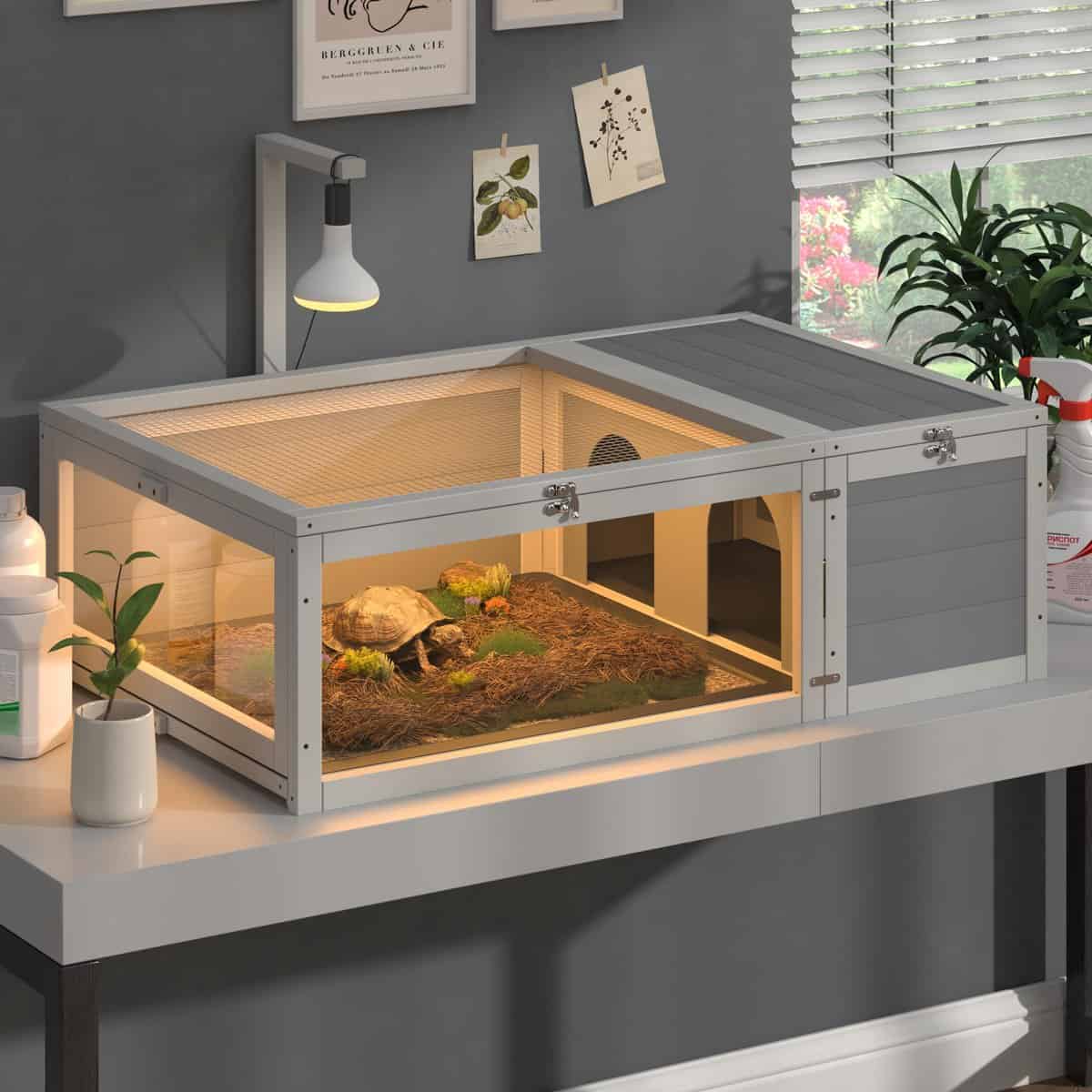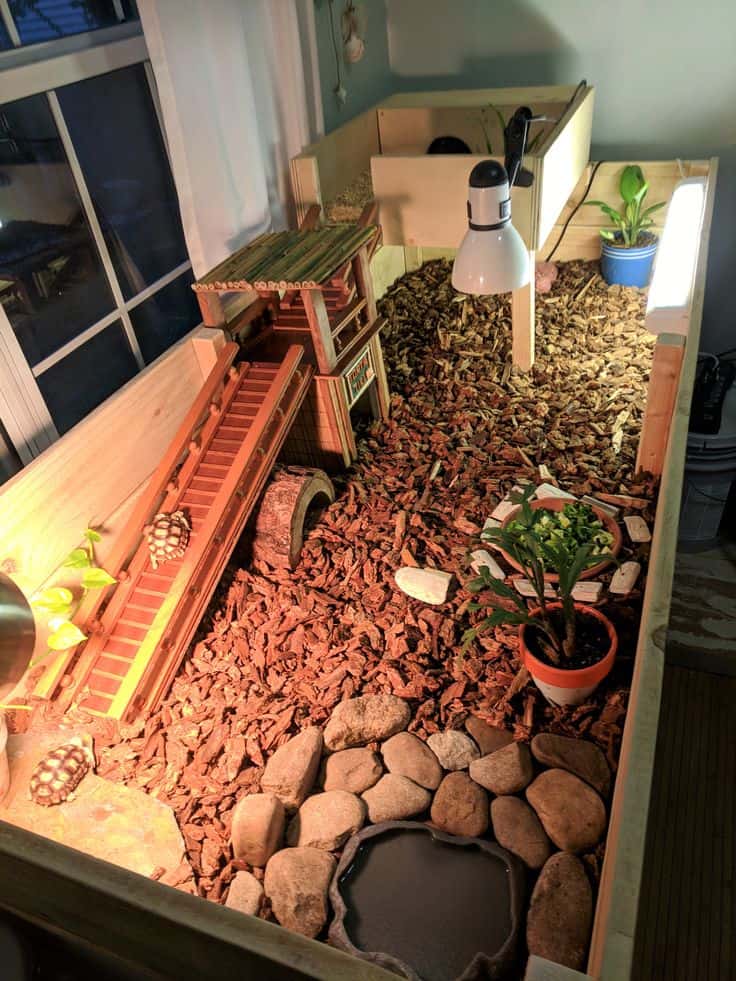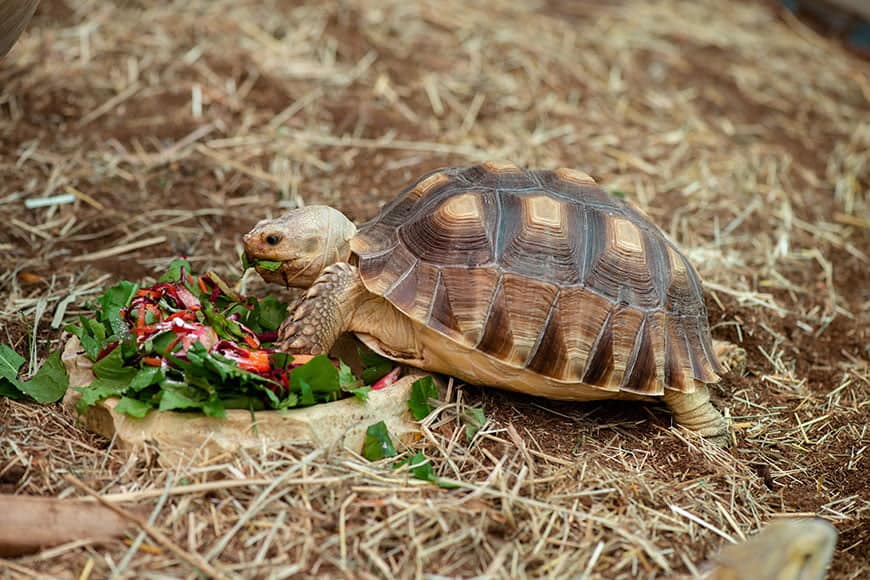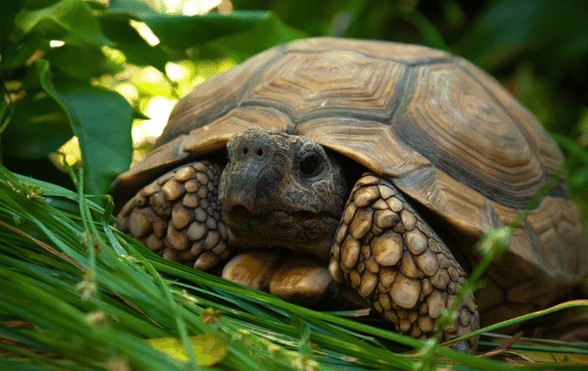Indoor tortoise terrariums should replicate natural habitats with ample space, substrate for digging, UVB lighting, a basking area, and a varied diet to support their health and well-being.
The Ultimate Tortoise Terrarium Setup: Tips for Lighting, Heating, and Humidity Control
Proper lighting is crucial for the health and well-being of tortoises kept in indoor terrariums. In the wild, tortoises rely on natural sunlight to regulate their internal body temperature, synthesize vitamin D, and maintain their circadian rhythms. When kept indoors, it is essential to provide artificial lighting that mimics the natural sunlight that tortoises would receive in their natural habitat.
Full-spectrum UVB lighting is particularly important for tortoises, as it allows them to produce vitamin D3, which is essential for calcium metabolism and overall health. Without adequate UVB lighting, tortoises can develop metabolic bone disease, a serious and potentially fatal condition. In addition to UVB lighting, providing a basking light is also important, as it allows tortoises to thermoregulate and maintain their body temperature.
Overall, proper lighting is essential for the overall health and well-being of indoor tortoises, and should not be overlooked when setting up a terrarium.
In addition to providing the right type of lighting, it is also important to ensure that the lighting is positioned correctly within the terrarium. The basking light should be placed in a way that allows the tortoise to bask and warm up effectively, while the UVB light should be positioned at the correct distance from the basking area to ensure that the tortoise receives the appropriate levels of UVB radiation. I
t is also important to provide a day-night cycle for the tortoise, as this helps to regulate their circadian rhythms and overall behavior. This can be achieved by using a timer to control the lighting in the terrarium, ensuring that the tortoise receives a consistent day-night cycle. Overall, proper lighting and its correct positioning are essential for creating a suitable indoor environment for tortoises.
Heating Options for Indoor Tortoise Terrariums
In addition to proper lighting, providing the right heating options is essential for creating a suitable indoor environment for tortoises. Tortoises are ectothermic animals, meaning that they rely on external sources of heat to regulate their body temperature. In the wild, they would bask in the sun to warm up, so it is important to provide a suitable heat source in their indoor terrarium.
One common option for heating indoor tortoise terrariums is the use of heat lamps or ceramic heat emitters. These can be used to create a basking spot within the terrarium, allowing the tortoise to warm up as needed. It is important to monitor the temperature within the terrarium and adjust the heat source as necessary to ensure that the tortoise has access to the right temperature gradient.
Another heating option for indoor tortoise terrariums is the use of under-tank heating pads or heat mats. These can be placed underneath part of the terrarium to create a warm area for the tortoise to rest and regulate its body temperature. It is important to use a thermostat with under-tank heating pads to ensure that the temperature remains at a safe and consistent level for the tortoise. Overall, providing the right heating options is essential for creating a comfortable and suitable environment for indoor tortoises.
Humidity Control in Indoor Tortoise Terrariums
Maintaining the right levels of humidity within an indoor tortoise terrarium is essential for the health and well-being of the tortoise. In their natural habitat, tortoises are adapted to specific humidity levels, and it is important to replicate these conditions as closely as possible in an indoor environment.
The specific humidity requirements will vary depending on the species of tortoise, so it is important to research the specific needs of your tortoise and adjust the humidity levels accordingly. One common way to increase humidity within a terrarium is by using a substrate that retains moisture, such as coconut coir or cypress mulch. These substrates can be misted regularly to maintain the right levels of humidity within the terrarium.
In addition to using a suitable substrate, it may also be necessary to use a humidifier or misting system to maintain the right levels of humidity within the terrarium. This can be particularly important for species of tortoises that require higher humidity levels, such as those from tropical or rainforest habitats. It is important to monitor the humidity levels within the terrarium regularly and make adjustments as needed to ensure that the tortoise has access to the right conditions. Overall, maintaining the right levels of humidity within an indoor tortoise terrarium is essential for creating a suitable environment for these animals.
Choosing the Right Substrate for Tortoise Terrariums
Choosing the right substrate for an indoor tortoise terrarium is essential for creating a suitable environment for these animals. The substrate not only provides a comfortable surface for the tortoise to walk on but also plays a role in maintaining humidity levels and promoting natural behaviors such as digging and burrowing. There are several different types of substrates that can be used in tortoise terrariums, and the best option will depend on the specific needs of your tortoise species.
One common option for tortoise substrates is coconut coir, which is a natural substrate made from coconut husks. Coconut coir retains moisture well and can help to maintain humidity levels within the terrarium.
Another popular substrate option for tortoises is cypress mulch, which also retains moisture and provides a naturalistic appearance within the terrarium. Other options for tortoise substrates include topsoil, sand, and reptile carpet, each with its own advantages and disadvantages.
It is important to research the specific needs of your tortoise species and choose a substrate that meets those needs while also being safe and easy to maintain. Regardless of the type of substrate chosen, it is important to regularly clean and replace it as needed to ensure that the terrarium remains clean and hygienic for the tortoise.
Creating a Suitable Environment for Tortoise Hibernation
For some species of tortoises, hibernation is a natural part of their annual cycle, and it is important to create a suitable environment for hibernation within an indoor terrarium. Hibernation allows tortoises to conserve energy during periods of cold weather or food scarcity, and it is important to replicate these conditions as closely as possible in an indoor environment. One key factor in creating a suitable hibernation environment is providing a cooler temperature within the terrarium. This can be achieved by reducing the ambient temperature within the terrarium and providing a cooler area for the tortoise to rest.
It is also important to reduce the photoperiod (the amount of light) within the terrarium during hibernation, as this helps to signal to the tortoise that it is time to enter a period of dormancy. This can be achieved by using a timer to reduce the amount of light provided within the terrarium during hibernation months. It is important to research the specific hibernation requirements of your tortoise species and make adjustments as needed to ensure that they have access to a suitable hibernation environment. Overall, creating a suitable environment for hibernation within an indoor tortoise terrarium is essential for promoting natural behaviors and ensuring the overall health and well-being of these animals.
Maintaining Cleanliness and Hygiene in Indoor Tortoise Terrariums
Maintaining cleanliness and hygiene within an indoor tortoise terrarium is essential for promoting the health and well-being of these animals. A clean environment helps to prevent the buildup of harmful bacteria and parasites, which can lead to illness and disease in tortoises. One key aspect of maintaining cleanliness within a terrarium is regular spot cleaning, which involves removing any soiled substrate or waste from the enclosure on a daily basis. This helps to prevent odors and reduces the risk of bacterial growth within the terrarium.
In addition to spot cleaning, it is also important to perform regular deep cleanings of the terrarium to remove any accumulated waste or debris. This may involve completely emptying and cleaning the terrarium on a periodic basis, depending on the size of the enclosure and the number of tortoises housed within it. It is also important to regularly clean and disinfect any furnishings or decorations within the terrarium, as these can also harbor bacteria and parasites if not properly maintained. Overall, maintaining cleanliness and hygiene within an indoor tortoise terrarium is essential for promoting the health and well-being of these animals.
Tips for Setting Up a Safe and Enriching Indoor Tortoise Habitat
When setting up an indoor habitat for tortoises, there are several key factors to consider in order to create a safe and enriching environment for these animals. One important consideration is providing adequate space within the terrarium, as this allows the tortoise to move around freely and engage in natural behaviors such as walking, digging, and basking. It is also important to provide hiding spots within the terrarium, as this allows the tortoise to retreat and feel secure when needed.
Another important aspect of creating an enriching indoor habitat for tortoises is providing opportunities for exercise and mental stimulation. This can be achieved by adding obstacles or climbing structures within the terrarium, as well as providing opportunities for foraging or hunting behavior through enrichment activities such as hiding food or treats within the enclosure. It is also important to provide opportunities for social interaction with other tortoises if housing multiple animals together, as this helps to promote natural behaviors and socialization.
In addition to providing space and enrichment opportunities, it is also important to ensure that the terrarium is escape-proof and free from any potential hazards or dangers. This may involve securing any openings or gaps within the enclosure, removing any toxic plants or decorations, and ensuring that all heating and lighting equipment is safely installed and maintained. Overall, setting up a safe and enriching indoor habitat for tortoises involves careful consideration of their physical and behavioral needs, as well as regular monitoring and maintenance of their environment.
Conclusion
In conclusion, creating a suitable indoor environment for tortoises involves careful consideration of their specific needs in terms of lighting, heating, humidity control, substrate choice, hibernation requirements, cleanliness, hygiene, and overall habitat setup.
By taking these factors into consideration when setting up an indoor habitat for tortoises, one can help promote their overall health and well-being while allowing them to exhibit natural behaviors in captivity.
Originally posted 2024-05-02 03:11:06.




